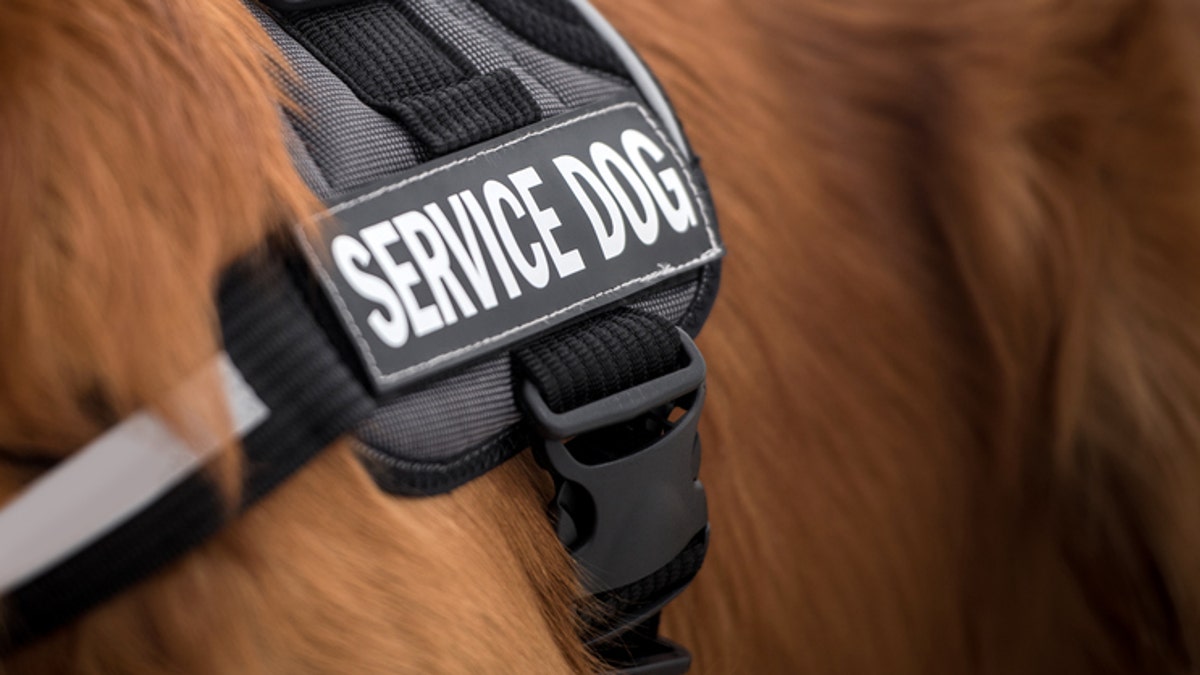
Close-up on the vest of a service dog (andresr)
The relationship between a service dog and a veteran is akin to a team walking a tightrope. To succeed, they must focus on each other, intently. Distract one, and both can stumble. When they are in sync, the intricate teamwork going on can appear effortless to the outside world. And this partly explains why some people, often quite innocently, insist on being a distraction. Hence the ubiquitous question:
Can I pet your dog?
Uh, no, not now. Not ever. Keep your paws off, please.
Would you want someone to ask if they could rub your heart surgeon’s head while she was operating on you? Would you think it appropriate if someone offered to rub your lawyer’s belly while he was trying to convince a jury of your innocence?
Probably not, right? You'd think these were grossly inappropriate questions and certainly needless distractions in the midst of critical, sometimes life and death, situations.
And that’s exactly how you should think about service dogs when they are about their work. Note the key word: work.
But that’s the thing. Service dogs are not pets. When their vest is on, they have an extremely important job to do.
In public, vest on, these dogs are engaged in life-saving tasks for their veterans. Guide dogs prevent blind or vision-impaired veterans from wandering into the street when a light is red. For veterans with prosthetic limbs, their dogs open doors, keep watch for things easily tripped over, or act as a brace when vets are walking or standing up. Service dogs for those with post-traumatic stress disorder are often on point, keeping potential triggers that would raise stress or anxiety levels for their veterans at bay. For veterans prone to seizures, their dogs will alert them if they sense an episode coming on.
We get it. These dogs are irresistibly cute. And clearly just the sight of one in a store or restaurant can turn normally reserved adults into children. Disabled veterans have seen grown men crawl under tables, barking to get a dog’s attention. And while they’re down there, may as well pet the pup, right? If it were them, they’d no doubt welcome having their meal interrupted so people could show their pet some love.
But that’s the thing. Service dogs are not pets. When their vest is on — the garment often emblazoned with the words “Service dog: Do not pet” — they have an extremely important job to do. They have undergone months, sometimes years, of intense training that costs tens of thousands of dollars — an expense currently not covered by the Department of Veterans Affairs. They are there to watch for and react to dangerous situations and await commands from their veterans. If you call to these dogs, or insist on talking to them, then, despite all that training — they are, after all, still dogs — they are potentially paying attention to you, not the veterans they are supposed to serve and protect. In other words, you’re bouncing up and down on their tightrope.
Think about it this way: If the service dog turns its head or body to see what you want, the veteran with vision loss could wind up stumbling and falling. Prosthetic limbs can be seriously damaged in the twists and turns of a tumble. Or the dog might not catch the early signs of a seizure, or miss something that causes problems for a vet with PTSD.
The Americans with Disabilities Act (ADA) actually requires owners to maintain control of their animals. Don’t make a tough job more difficult.
So far, we’ve just addressed how people react to service dogs. But their behavior toward disabled vets can be even more bizarre — and quite rude. For example, people often say, “I know it’s a service dog and he’s working, so I won’t pet him.” This is so irritating. It’s as if they are magnanimously making the decision to pet or not pet without asking prior permission. An analogy would be: “I know you have a purse and I know I am not to steal it, so I won’t.” How generous.
Worse is when people just reach out to pet a service dog, seemingly from every direction imaginable. Then they will get angry when the surprised disabled veteran turns and says, “Please don’t pet him, he’s working.” Their disturbing response? “Well, what’s wrong with you? You don’t look disabled.” People seem to genuinely believe they have a right to know this. (Maybe so they can decide in their own mind if it’s OK to pet the animal with the vest that clearly says “Do not pet”?)
That’s just wrong. There is never a need for a stranger to know a veteran’s medical history. In fact, the ADA doesn’t even allow staff in stores or restaurants to ask people with a service animal what their disability is. They are permitted two questions: Is the service animal required because of a disability? and What work or task has it been trained to perform? If veterans don’t have to disclose their disabilities in those situations, why would they ever make themselves vulnerable by blurting it out to strangers on the street?
The disabled veteran community has a slogan, Paws Off Please (POP), designed to educate people about interacting with the service animals that are becoming more and more commonplace in public. So, lesson one: If a dog has a vest on, that means it’s working; don’t pay attention to it.
But, please, don’t ever ignore the veterans. Instead, be sure to thank them for their service.
